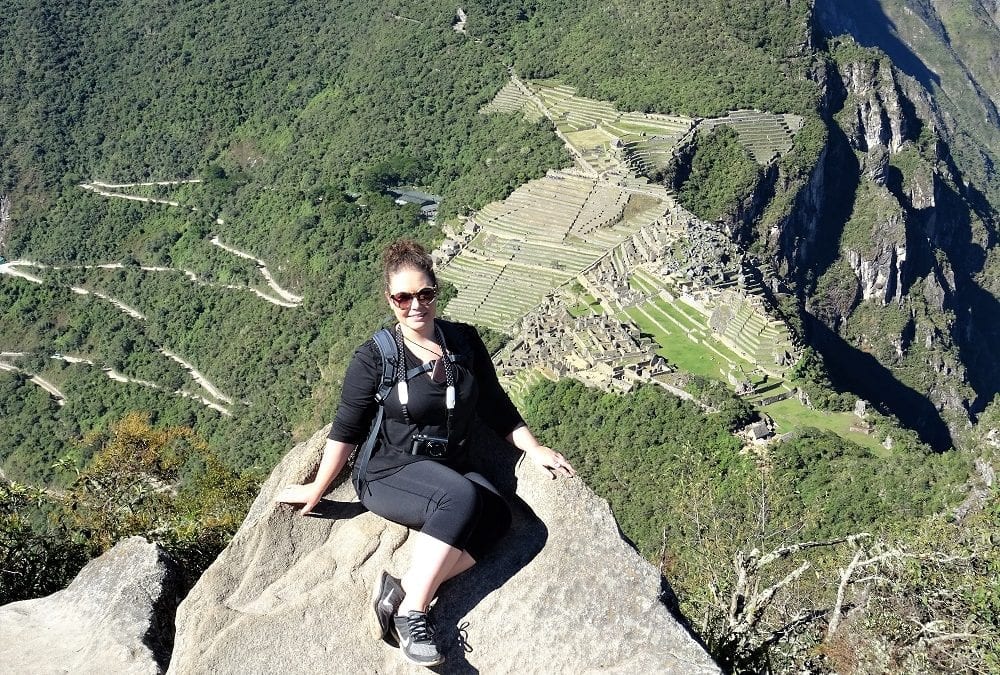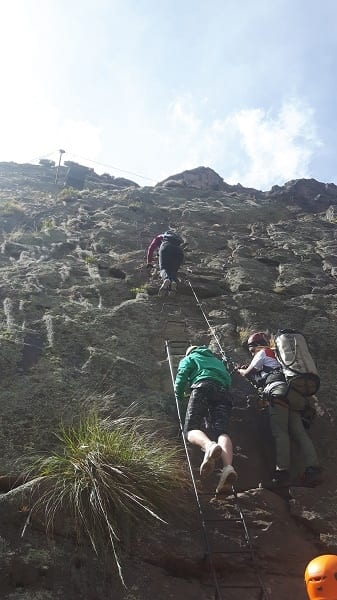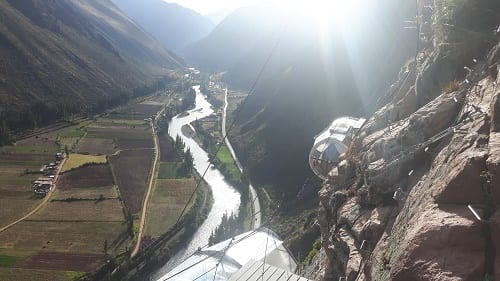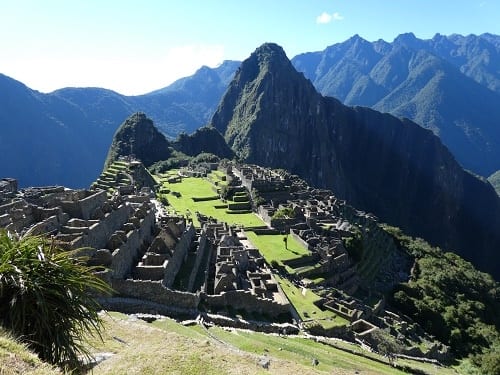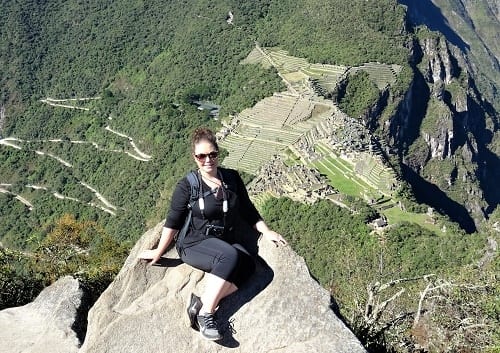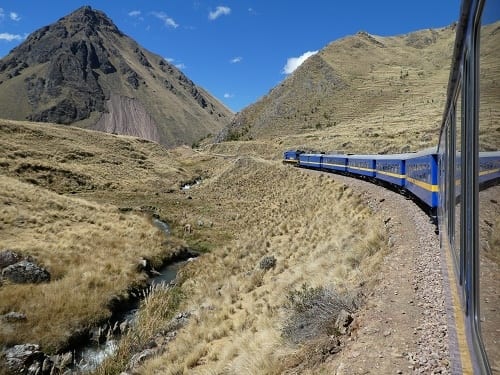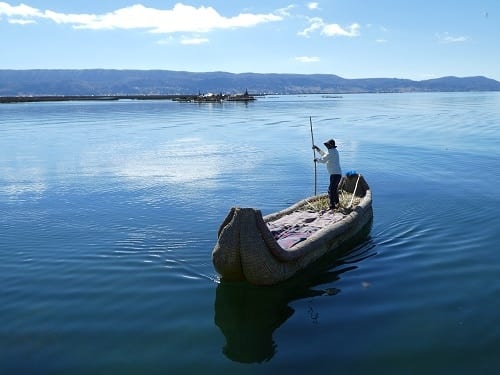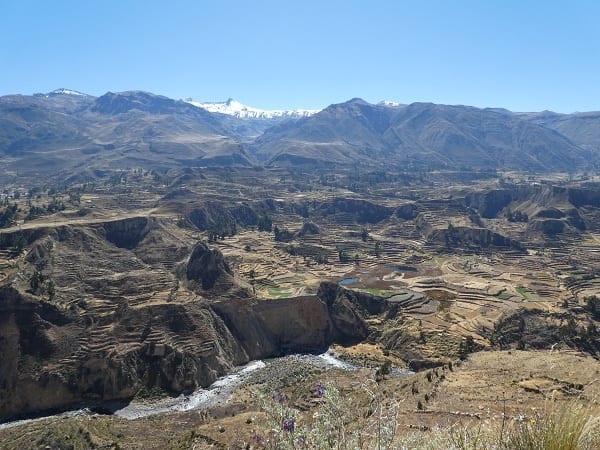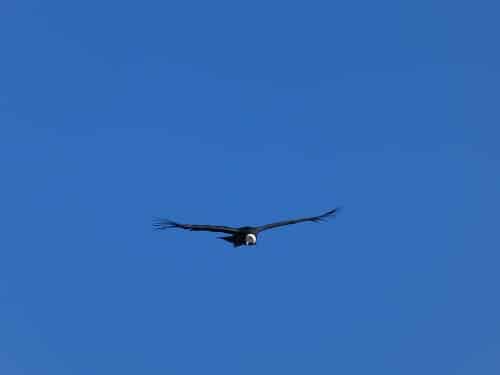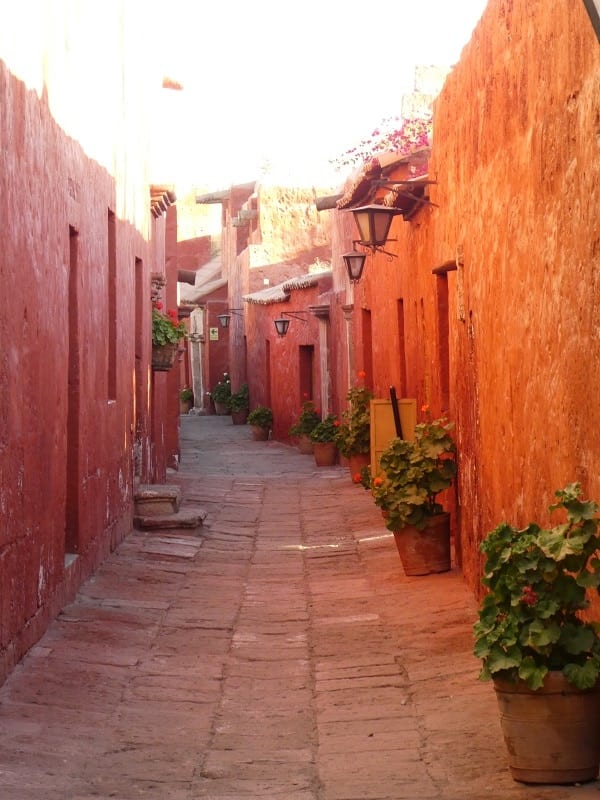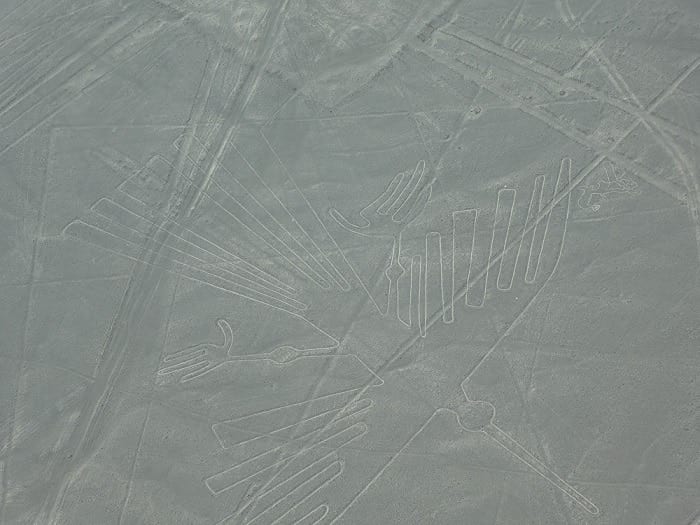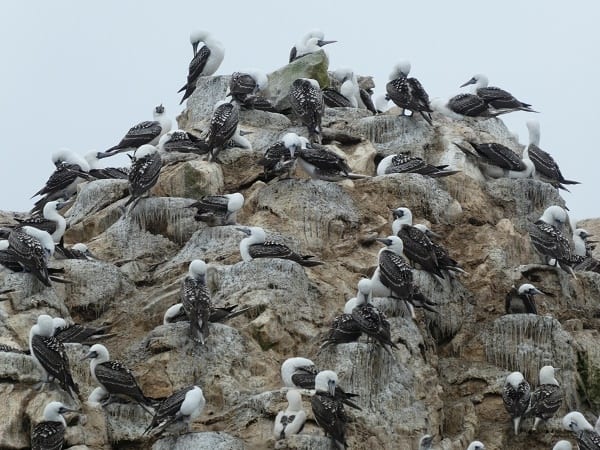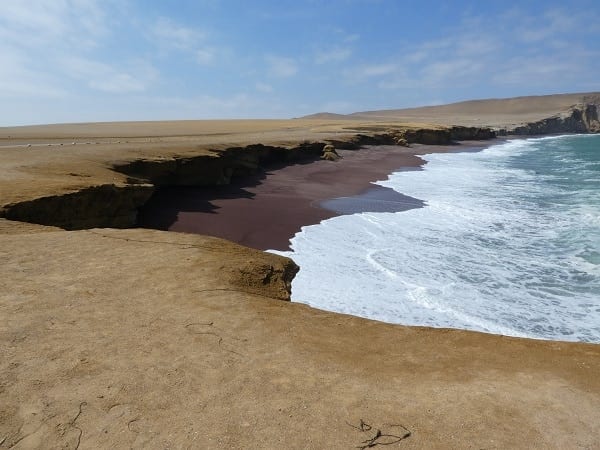Camilla writes: ‘I was the first of our group to arrive at Gatwick for our British Airways flight to Lima, perhaps a sign of how keen I was to get to Peru. We checked into a hotel near the airport and were up early the next day to catch our onward flight to Cusco. Here we transferred straight to the base of Sky Lodge in the Sacred Valley.
Looking up to try to see where we were heading I noticed some tiny dots high above us on the side of the sheer rock face. This was another group scaling the Via Ferrata on their way to the Sky Lodge, which is comprised of transparent luxury capsules that hang 400m above the Sacred Valley. We were about to climb a series of fixed ladders and cross a cable bridge to get to our much-deserved lunch.
Unless you are prepared to undertake a pretty gruelling hike including ziplines or climb the Via Ferrata to get to the capsules, a stay at Sky Lodge may not be for you! Five of our group of 10 accepted the challenge. We climbed for almost 3 hours straight up, sideways and around overhangs. There is a safety line alongside you the whole way and eventually we arrived at the bridge. We decided a better description was a tightrope! In reality it was a couple of interlaced cables no more than 6 inches wide to side step along and a single cable around shoulder height to most (head height for me!) to hold onto for balance/cling to for dear life!
To cross the bridge we were first required to edge out onto the cables whilst perching our bottoms reassuringly on the side of the rock wall. Once in position Danielle our very patient and agile guide explained that on the count of three he would lean out against the line that we were holding onto for balance and when he did this we needed to lean forward, stand up and make our way to the other side. Sounds simple enough, apart from the fact that we were 300m above the ground looking straight out across a valley! Only a fool would not be frightened, but we all managed it – just!
The capsules of the Sky Lodge were a welcome sight, suspended from the cliff face and a glass of bubbly was the best fix for my shaky knees. A four-course lunch was served to us in the dining capsule and I don’t think the view gets much better from your table. After lunch I also got to experience this view from the toilet capsule too!
Back on the Via Ferrata it was a short climb to the first of the seven zip lines to get us back to the bottom. Chasing the daylight, we were clipped on and sent flying across the mountain side. The ziplines ranged 150m to 700m, the latter requiring us to travel in tandem to ensure there was enough weight to reach the other side. After 5 hours of climbing, eating and ziplining I was ready to hit the hay!
The next morning it almost felt like Christmas as today I would finally get to see Machu Picchu!
We transferred to Ollantaytambo train station to embark on the 1.5-hour train journey to Aguas Calientes with Inca Rail. Our first-class seats were comfortable and these carriages benefited from panoramic views, a bar carriage and live music. On arrival in Aguas Calientes we met our guide and caught the bus up the winding mountain road to the entrance of Machu Picchu.
I could hardly contain my excitement and the rest of the group were well aware of my enthusiasm by the time we arrived. Our guide Julio was passionate about the ancient Inca citadel and spoke to us through our ear-pieces in such a soothing tone that none of the magic of being there was lost.
There are three marked routes to take you through the citadel and surrounding terraces. We took the middle route and spent three hours exploring the main structures of the site including Inti Watana, Temple of the Sun, Temple of the Condor, Temple of the Three Windows and the Main Temple as well as homes, irrigation systems and the Mirror Pools. Lamas roam around the site, hummingbirds visit the flowers and I even spotted a chinchilla tucked up in the Temple of the Condor.
It is astonishing to learn how the Incas studied their environment to carve and position rocks as calendars or compasses using astronomical alignments and shadows. I was happy in the thought that there is still some mystery surrounding the actual former use of this place. We had been blessed with blue skies and by visiting in the afternoon it felt like we had the place to ourselves. Reluctantly we were among the last to leave that day, but I would be back tomorrow!
Besides being the gateway to Machu Picchu, Aguas Calientes is famed for its thermal baths and I could not think of a better way to soak up all that I had seen than a dip in the hot pool before another delicious dinner.
I was ready at the crack of dawn for our next challenge: Huayna Picchu. Translating to Young Mountain, Huayna Picchu is not the only peak that can be climbed, Machu Picchu, or Old Mountain, is higher, but less steep and provides a less challenging alternative. A re-entry permit also gives you the opportunity to walk to the Sun Gate, where some of the most iconic images of Machu Picchu are taken as it first appears from the Inca Trail. We were lucky enough to arrive just in time to see the sun appear over the surrounding peaks.
The climb and descent took me around 3 hours with a large part of that spent sitting on a rock at the top of Huayna Picchu trying to take in every bit of the 360° view. I could certainly feel the altitude as I made my way up the uneven steps, going through a cycle of climbing, feeling breathless, resting and climbing again. The handrails were all the more necessary as the shaky knees returned on the descent, we made our way down the seemingly endless steep stone steps, at one point squeezing through a narrow crack in the mountain side.
In Aguas Calientes we caught our train back to Ollantaytambo and took the transfer to Cusco. I managed to squeeze in dinner at Calle del Medio on the main square before a much-needed shower and bed.
I awoke the next day looking forward to exploring. We were in town for the Anniversary of Cuzco celebration. Every day during the festivities groups of dancers from every region of the country come and perform in the main square. They each bring musicians and dress in their respective traditional costume. The music and dancing continued through the day and night and the atmosphere was electric.
To get orientated our guide Dante led us through the streets pointing out the Inca foundations that have stood the test of time, on which the city sits. We visited the Tempo de San Blas, the city gate, food markets and the main square. I spent the afternoon eating delicious local food, drinking beer and watching the constant flow of dancers through the square. As a solo female I felt very safe and was hardly hassled by the street sellers.
Before dinner we visited Cusco Planetarium. Although the day had been almost too warm, once the sun was gone the temperature dropped and I was wrapped in blankets from head to toe as we spotted the Southern Cross and learned about the Incas using the dark parts of the Milky Way to navigate. There was just time to study Jupiter, the Jewellery Box constellation and the moon through a telescope before finally enjoying our dinner at Chullpi Cusco.
An early start ensured we did not miss our train from Cusco to Puno with Peru Rail. It was cold in the morning but luckily the train provided blankets and I snuggled up under mine to get warmed up as the train began the 11-hour journey. You may think this sounds like a long time to be stuck on a train, but it flew by and was a real highlight of my trip.
The scenery is ever changing from lush green countryside among mountains and rivers past farmland and small settlements with locals walking alongside the tracks to dry yellow grasslands speckled with lamas and fringed with snowy peaks. The first of the entertainment kicked off at 10am with a band playing traditional music from various regions around Peru accompanied by a dancer whose costume changed with each song to fit the region’s traditional dress. If the lively music played on drums, guitar and several wind instruments wasn’t enough to get the crowd going, the complimentary piscos cocktails certainly were.
We were served a delicious 3 course lunch at our comfortable tables as the scenery rolled by. Soon we were halfway along the track and at the highest point of the journey, La Raya at 4319m. Here the train stopped briefly and it was impossible to resist the shopping opportunities as the local women flaunted their alpaca wool products at very reasonable prices.
Rather suddenly there was a change of scenery as the train reached Juliaca, a small industrial town. This was my first real experience of rubbish and pollution since we left Lima. Alongside the train tracks were stalls selling everything you could imagine from engine parts to hair ties. There were people everywhere of all ages and cars and tuk tuks crossed the tracks as soon as we had passed by. The children were excited to see the train, but even the adults were waving to us as we slowly passed through their busy lives. It wasn’t much longer before we reached Puno and this fabulous journey was over. We transferred to the hotel for a spot of dinner before bed.
Peaking out of the window of my hotel room in the morning I got my first glimpse of Lake Titicaca as the sun was rising. After breakfast we transferred to Hotel Titilaka who were hosting us for our full day on the world’s highest navigable body of water. On the way we passed farmland and lots of ‘Rasta Donkeys’ as our guide explained the history of the two lines of ancestry, Aymara and Quechua, in the area that have still not really mixed to this day.
Onboard the boat our guide Alberth filled us in on what the day would hold as we made the 1.5-hour journey to the Uros floating islands, our first stop. Here we would have the opportunity to meet the skilled reed raftsmen and expert weavers both famous for their crafts. We were collected from our boat by a smaller vessel made entirely of reeds and transferred to the island to get a closer look. We were greeted by excited children and the happy community of people living on this particular island.
We were shown the ancient ancestral techniques used to keep their islands afloat, among other aspects of their remarkable heritage. I experienced a true contrast of tradition and the modern world when I was invited to look inside one of the homes and the men were engrossed in the World Cup match between Peru and France on their flat screen TV!
Our next stop was another 1.5 hours away by boat. We had been blessed with calm waters and blue skies and I snuggled under my blanket as we crossed the enormous body of water to the Island of Taquile. With the white peaks of the Bolivian Andes on the horizon behind us we arrived on the shores of Taquile just in time for lunch. We walked across the island and were met by the local ‘Taxmen’ who escorted us to the home of our boat captain where we were being hosted for lunch. We were served a spectacular buffet of local dishes including trout, chicken, clay and corn surrounded by views of Bolivia’s Cordillera Real.
There is a heavy Spanish influence on the island, the women dress in the style of the Andalusians and the men like Moors. Men also sport a long traditional hat with a pompom on the end. The mood of the individual is portrayed by the position of the pompom, when it sits to the right they are happy, to the back they are indifferent and to the left they are sad. As the news spread that Peru were out of the World Cup having taken 36 years to finally be a part of the competition, the pompoms shifted to the left!
We continued our walk to the opposite shore of the island where we were picked up by our boat and returned to the mainland. With uninterrupted views across the lake we were set up with sundowners and blankets by the firepit to enjoy the sunset from the Peruvian shore. Once it was dark we enjoyed our final meal together as a group of 10.
And then there were 2…
A fellow agent and I had decided to extend the trip as there was more of Peru we wanted to see, so this morning we set off on our own adventure. Waving goodbye to the wild guinea-pigs on the lawns of the hotel we started the 6-hour transfer to the Colca Canyon with our guide Jean. We stopped off at Lake Lagunillas with flamingos feeding at the water’s edge. As we drove along the quiet road the countryside around us was scattered with lamas, alpacas and vicuna. This journey would bring us to the highest point of our travels in Peru, 4910m above sea level. In preparation for the altitude our guide stopped off to get us some tea made from three local herbs to help our heads and stomachs acclimatise. Smoking away across the flat ground covered in cairns was Sabancoyo volcano, taunting onlookers with the occasional belch of fluffy white smoke.
We soon reached Chivay, a small friendly town where we enjoyed a lunch of local dishes such as alpaca, quinoa, rehydrated potatoes and trout. Not far from here was our accommodation for the night, the Colca Lodge. Nestled in the canyon of the Colca River, the lodge boasts stunning views of the valley, but most importantly benefits from the natural hot-springs in the area. I was straight in the hot pools and stayed there until well after dark accompanied by a large glass of blanco de balnco and the stars of the southern sky.
Our guide Grace collected us for an early start the next day to ensure out best chance of seeing condors at Condors Cross. We first made a stop in Yanque Village, the original capital of the region. In the main square the older school children were performing a love dance, the boys were dressed as women with tasselled hats to cover their faces. The dancers wore intricately embroidered skirts, which whipped around their legs as they spun around.
We found a good spot high on the edge of the canyon to hopefully spot some condors and it didn’t take long for a juvenile to come soaring into view, followed by another and an adult. Soon there were nine condors riding the thermals and gliding effortlessly through the canyon.
The breeze through the valley was bitter and after watching for some time we took shelter in the bus. We decided go for a walk along the cliff edge to warm up, the condors chose to join us and lead the way through the sky just ahead of us. There was no one else around and we couldn’t believe our luck, also spotting giant humming birds, an American kestrel, hawks, eagles and mountain cara cara.
After lunch and a wander around Chivay it was time to make the drive to Arequipa. Surrounding the city are 3 volcanoes: Pichu Pichu is the smallest and is extinct, the highest is Chachani which is dormant and then there is Mistii which is still active. They make for a dramatic backdrop!
Once we got to the hotel I was raring to see some of the city. I made my way to the cathedral in time to see the largest organ in the country being played. I was surprised by the white and peach interior, expecting something more dramatic. I felt very comfortable wandering the streets alone, even after dark. Well worth it to see the cathedral lit up so beautifully.
In the morning we made our way to the Indian market and along San Francisco and Santa Catalina for some necessary shopping. We had time to relax with a cold cerveza overlooking the main square and enjoyed lunch in a cool courtyard before meeting our guide Beatriez for the afternoon. We were taken to a viewpoint called Mirador de Carmen Alto overlooking the Chilli River valley. From here we could see all three volcanoes and the small plots of farmland where people grew grains and vegetables on the outskirts of the city. We then stopped off at a second viewpoint by the Parroquia de Yanahuara church, wandered the streets of San Lazaro neighbourhood and tried the local ice cream Queso Helado Arequipeno.
Our last stop on this tour was Monasterio de Santa Catalina, this impressive complex founded in 1579 is the only convent in the world comprised of a city within a city. It was once home to over 500 women including nuns and their servants, now only 20 nuns reside here.
The brightly coloured walls were very photogenic and many homes, cloisters and paintings where fascinating to explore.
Now it was time for the part of the trip I had been dreading: the 12 hour night bus from Arequipa to Paracas. The bus didn’t seem too bad, comfy reclining seats, blanket, pillow and even entertainment (in Spanish with subtitles). When the meals were passed out the locals all got theirs first, it looked like a nice hot meal of rice and stew. Then a white bun and piece of cake were thrown at us as the attendant swiftly slammed the door! Perhaps it was safer on a 12 hour bus journey to have the “tourist meal”. I think by some miracle I got a full 8 hours sleep, possibly the best rest of the trip so far! We arrived into Paracas and went straight to breakfast at Fruzion, where they serve exotic frozen juices.
Thankfully I had ust enough time for a quick shower before heading to the airport to catch our flight over the Nazca Lines, a series of mysterious ancient designs and pictographs carved into the ground in the Nazca Desert. We waited until 12 people had checked in to fill the plane, then it was time to board. The aircraft offered 6 window seats on either side of the plane. The flight south to Nazca took around 30 minutes. We flew the total circuit including the whale, compass, astronaut, dog, monkey, dog, hummingbird, sider, condor, heron, parrot, hands and tree.
Soon my stomach was starting to feel a little queasy and as the plane continued to bank from one side to the other to give both sides a full view of each image I seriously wondered how long it would be before I saw that exotic frozen juice again. Luckily my stomach was just strong enough to withstand the 40 minutes it took to fly over the lines and started to settle down again on the 30 minute drive back to Paracas.
The next morning we were off to the Ballestas Islands. After breakfast we hopped onto our small covered boat, stopping at the edge of the Paracas National Park to view The Candelabra, a prehistoric geoglyph found on the northern face of the Paracas Peninsula at Pisco Bay. The journey to the islands took about 30 minutes.
We saw pelicans, boobies, penguins, sealions, sunfish, starfish and a vast array of other sea birds. The waters were red with krill and the rocks were white with guano, which had a rather pungent aroma. We shared a quiet moment with a sealion as she breastfed her pup and motored around various bays and smaller islands to see all the abundant life supported by the desolate rocks, before heading back to the mainland.
In the afternoon I was met by my guide Pilar to explore some of the Paracas National Park. The vast landscape of multi-coloured dunes was once under water. Evidence of this is visible in the ground in the form of seashell fossils still in place from 36 million years ago. We drove to various viewpoints with panoramic views across the landscape. The red colours coming from iron, the black from carbon and the white from guano of course! We visited the red beach, the sand of which bears no resemblance to the golden cliffs surrounding it.
Back at the hotel more seafood was in order while I waited for the transfer to the bus station for the not so long 4 hour bus journey to Lima. We arrived late into the capital and were glad of our beds.
The final day of this epic adventure started slowly. In the afternoon we were collected for a city tour of Lima. Our guide Jenny took us from Miraflores, the tourist and coastal district, through Sunny Cuadro, the business district, to the main square in central Lima. The traffic was bad, but we were in no rush. There were protests elsewhere in the city and the Cathedral Square was closed off. The police kindly let us through and we practically had the square and cathedral to ourselves. Inside the cathedral it was unlike any I had seen before. Along both sides were elaborate alters carved, painted and in mosaic, each with its own deity. Walking across the square seemed surreal with only the company of police!
Next we visited the Aliaga family home. Still lived in by the family, certain rooms are open to the public. The elaborately decorated reception rooms and courtyard were a surprise considering the house’s plain façade. We wandered through the pink and white post office to find our car and take our journey to the final stop on the tour, the Museo Larco. Established in 1926 by Rafael Larco Hoyle who gathered his vast collection of pre-Columbian pottery from a young age, the storage rooms are open to the public and it is well worth a visit. Some may also enjoy the room of erotic pottery, which leaves very little to the imagination!
Sadly it was time to head to the airport and board our night flight back to the UK. It had been an amazing experience and I was still catching my breath from all I had seen and done for a good few days after arriving home. This also the longest blog I’ve yet written, so that tells it’s own story!
My thanks to Daniel and all the team at Distinctive Americas for hosting me on this superb adventure.

